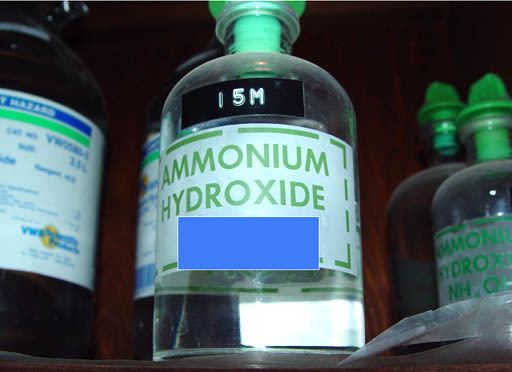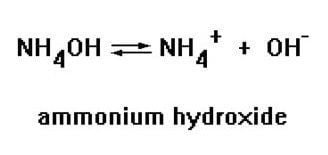Related compounds Molar mass 35.04 g/mol Boiling point 24.7 °C Appearance Colourless liquid | Formula NH4OH Density 880 kg/m³ Melting point -91.5 °C | |
 | ||
Ammonia solution, also known as ammonium hydroxide, ammonia water, ammonical liquor, ammonia liquor, aqua ammonia, aqueous ammonia, or simply ammonia, is a solution of ammonia in water. It can be denoted by the symbols NH3(aq). Although the name ammonium hydroxide suggests an alkali with composition [NH4+][OH−], it is actually impossible to isolate samples of NH4OH, as these ions do not comprise a significant fraction of the total amount of ammonia except in extremely dilute solutions.
Contents
- Make ammonium hydroxide
- Basicity of ammonia in water
- Saturated solutions
- Household cleaner
- Alkyl amine
- Furniture darkening
- Food production
- Tobacco processing
- Aquarium Fishless cycling
- Treat straw for cattle
- Laboratory use
- References

Make ammonium hydroxide
Basicity of ammonia in water

In aqueous solution, ammonia deprotonates a small fraction of the water to give ammonium and hydroxide according to the following equilibrium:
NH3 + H2O ⇌ NH4+ + OH−.In a 1M ammonia solution, about 1.42% of the ammonia is converted to ammonium, equivalent to a pH of 11.63. The base ionization constant is
Kb = [NH4+][OH−]/[NH3] = 1.8×10−5Saturated solutions

Like other gases, ammonia exhibits decreasing solubility in solvent liquids as the temperature of the solvent increases. Ammonia solutions decrease in density as the concentration of dissolved ammonia increases. At 15.6 °C (60.1 °F), the density of a saturated solution is 0.88 g/ml and contains 35% ammonia by mass, 308 g/l w/v, (308 grams of ammonia per litre of solution) and has a molarity of approximately 18 mol L−1. At higher temperatures, the molarity of the saturated solution decreases and the density increases.
When solutions that are saturated at cold temperatures are sealed in containers and subsequently warmed, the concentration of the solution decreases and the vapor pressure of ammonia gas increases. Unsealing such containers can lead to a burst of ammonia gas. In extreme cases, the containers could rupture.
From a chemist's perspective, one should be aware that the concentration of a saturated solution is continually dropping as the container is handled in a warmer environment. Thus, old samples of ammonium hydroxide will deviate from 18 M, as can be verified by titration.
Household cleaner
Household ammonia is dilute ammonium hydroxide, which is also an ingredient of numerous other cleaning agents, including many window cleaning formulas. In addition to use as an ingredient in cleansers with other cleansing ingredients, ammonium hydroxide in water is also sold as a cleaning agent by itself, usually labeled as simply "ammonia". It may be sold plain, lemon-scented (and typically colored yellow), or pine-scented (green). Commonly available ammonia with soap added is known as "Cloudy ammonia".
Alkyl amine
In industry, ammonium hydroxide is used as a precursor to some alkyl amines, although anhydrous ammonia is usually preferred. Hexamethylenetetramine forms readily from aqueous ammonia and formaldehyde. Ethylenediamine forms from 1,2-dichloroethane and aqueous ammonia.
Furniture darkening
In furniture-making, ammonium hydroxide was traditionally used to darken or stain wood containing tannic acid. After being sealed inside a container with the wood, fumes from the ammonium hydroxide react with the tannic acid and iron salts naturally found in wood, creating a rich, dark stained look to the wood. This was commonly used during the arts and crafts movement in furniture- a furniture style which was primarily constructed of oak and stained using these methods.
Food production
Ammonium hydroxide is used as a leavening agent or acidity regulator and is classified by the Food and Drug Administration as generally recognized as safe (GRAS). Its pH control abilities make it an effective antimicrobial agent.
Tobacco processing
According to Phillip Morris USA, quantities of up to 0.3% ammonium hydroxide are used in tobacco for flavor enhancement and as a processing aid.
Aquarium Fishless cycling
Ammonium hydroxide is used by aquarists for the purposes of fishless cycling, but this requires that there are no surfactants or scents, it should be colorless and shouldn't foam when shaken up.
Treat straw for cattle
Ammonium hydroxide is used to treat straw, producing "ammoniated straw" making it more edible for cattle.
Laboratory use
Aqueous ammonia is used in traditional qualitative inorganic analysis as a complexant and base. Like many amines, it gives a deep blue coloration with copper(II) solutions. Ammonia solution can dissolve silver oxide residues, such as that formed from Tollens' reagent. It is often found in solutions used to clean gold, silver, and platinum jewelry, but may have negative effects on porous gem stones like opals and pearls.
When ammonium hydroxide is mixed with dilute hydrogen peroxide in the presence of a metal ion, such as Cu2+, the peroxide will undergo rapid decomposition.
